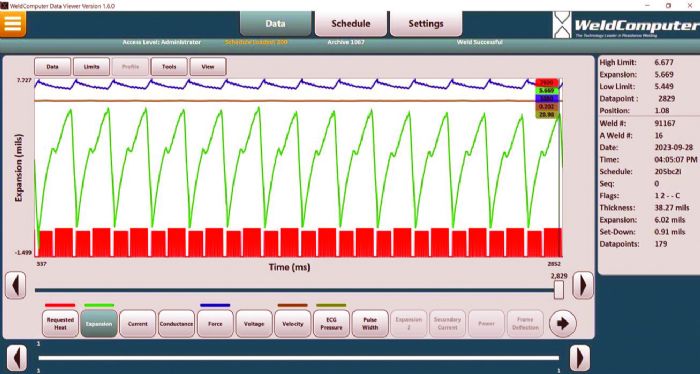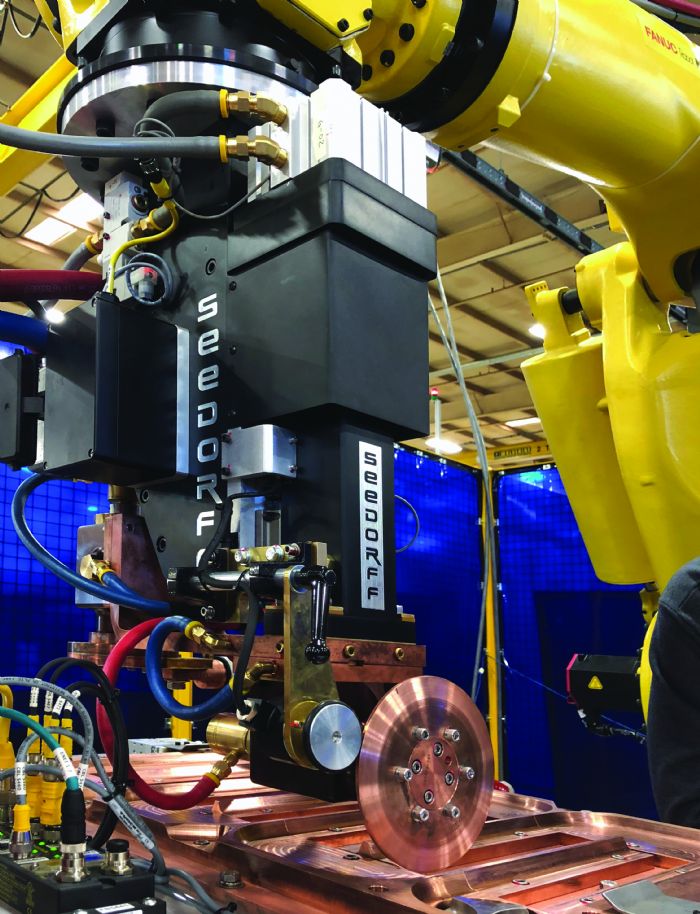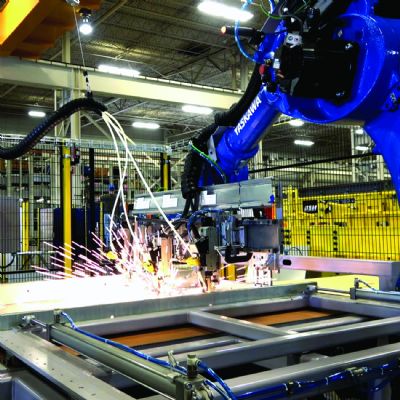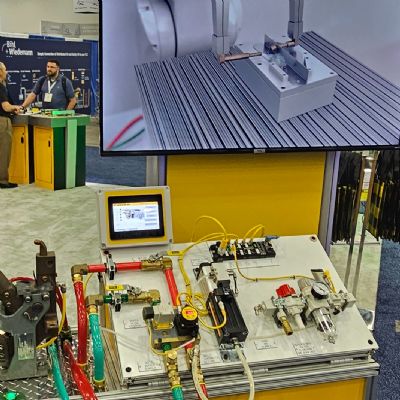Read on as we share some visions for the future of RW and offer six predictions for how the application of AI may transform this field.
1. AI will lead to robotic-welding automation becoming the norm.
In the next two decades, AI-driven robotic-welding automation is set to revolutionize RW applications. This technology will enhance robot trajectories, manage the handling and feeding of materials into machines, establish adaptive weld schedules to optimize welding performance, and oversee the removal and transfer of welded materials to subsequent production stages. Additionally, it will segregate parts that fail to meet all quality-control standards. Consequently, robotics will dominate RW, replacing traditional human-led methods.
Example—Flash/Butt welding: AI-guided welding systems automate flash and butt welding operations that enhance productivity and repeatability by integrating AI-driven path planning, adaptive control and real-time feedback mechanisms. By coordinating robotic motion with welding parameters, AI-enabled systems optimize weld quality and throughput while minimizing cycle time and material waste.
Prediction likelihood: More likely than not. This shift to robotic-welding automation is not due solely to AI. The RW industry faces a talent shortage and welding-skills gap that continues to widen as many experienced welding engineers head toward retirement without younger tradespeople ready to take their places. Robotics ensures business continuity as these skilled engineers leave the workforce, while reducing the need for trained engineers. AI will accelerate this change by making robots smarter and more capable of increasing output as humans shift into more of a monitoring role.
2. RW engineers will turn to generative-AI (genAI) tools to learn and improve their welding processes, reducing the need to be experts in order to create perfect welds.
By 2050, genAI will be incorporated into RW technologies, enabling engineers to prompt the AI to act as a virtual RW expert—answering questions, providing explanations and offering guidance to optimize welding parameters.
Example—Spot welding: A welding engineer communicates instructions into a genAI system to optimize welding parameters for spot welding aluminum sheets based on material properties and joint configuration. The AI iteratively refines parameter sets, considering factors such as weld strength and distortion, and provides visualizations and reports to aid interpretation.
Prediction likelihood: Likely. GenAI tools such as ChatGPT have opened the door for massive RW transformation. The natural language-processing capabilities and vast knowledge base of GenAI solutions can help welding engineers enhance their productivity, decision-making processes and welding knowledge to improve weld quality, process efficiency and welding innovation. This can take many forms: knowledge acquisition and explanations for common welding-related questions; problem-solving and troubleshooting assistance; process optimization; documentation and reporting; and even serving as a training resource for novice welders.
3. AI will optimize welding parameters automatically for every weld on any material.
 In the coming decade, several RW-control technologies will incorporate AI algorithms to fine-tune parameters dynamically, such as electrode force, current and duration. This advancement will lead to stronger, more uniform welds across a range of materials and joint designs.
In the coming decade, several RW-control technologies will incorporate AI algorithms to fine-tune parameters dynamically, such as electrode force, current and duration. This advancement will lead to stronger, more uniform welds across a range of materials and joint designs.
Example—Projection welding: AI algorithms can optimize parameters such as electrode force, welding current and weld time based on material thickness, type and joint design. By analyzing real-time sensor data and historical welding performance, AI-driven systems can adjust parameters dynamically to achieve optimal weld quality and efficiency.
Prediction likelihood: Already available, with opportunities to improve. Current adaptive controls can adjust an RW machine’s ability to yield consistent, high-quality welds in real time using welding data to account for many variables. Future weld-control innovations could be smart enough to recognize the material being welded and adjust the entire weld schedule accordingly.
4. AI will improve RW quality-control processes and standards.
By 2030, AI-powered quality control will enable instantaneous weld inspection, detecting imperfections with unmatched accuracy to ensure that welds meet the highest quality standards.
Example—Seam welding: AI-driven quality-control systems can monitor seam welds for defects such as cracks, porosity or irregularities. By integrating advanced monitoring technologies and machine-learning algorithms, these systems provide real-time feedback to operators, facilitating prompt intervention and quality assurance.
Prediction likelihood: Already available, with opportunities to improve. Today’s RW monitors provide rich data to assess quality in real time for every weld. Future advanced systems will augment this data using precision AI-enabled systems to predict the occurrence of defects such as insufficient nugget size, expulsion or incomplete fusion. By analyzing data captured during the welding process, AI algorithms can better detect anomalies and trigger immediate corrective actions based on the available information collected about each weld. The combined image-analysis and monitoring data will ensure that only the highest-quality welds leave the factory.
5. AI will impact how we anticipate preventive maintenance.
By 2035, AI-powered predictive maintenance (PM) in RW will become standard, forecasting maintenance needs and cutting downtime by spotting and fixing potential issues proactively, before they disrupt production.
Example—Seam welding: In seam-welding operations, AI can anticipate maintenance needs by monitoring factors such as electrode wear, cooling-system efficiency and seam-tracking accuracy. This PM approach minimizes downtime and ensures continuous operation by addressing potential problems before they impact production.
Prediction likelihood: Very high. Machine-monitoring technology already can help identify PM issues before they lead to machine downtime. AI will make these systems smarter, helping operators know exactly what maintenance to perform and when. Some of this already is handled via managed services designed to monitor and optimize proactively an RW machine’s mechanical and electrical performance, but AI likely would reduce reliance on humans for these functions.
6. Data for each weld will become just as important to welding manufacturers’ customers as the physical
part delivery.
AI offers the capability of presenting important data to users of RW technology in forms that enable quick understanding as well as rapid reporting and action.
Example—Seam welding: Companies performing seam welding will harness advanced AI and monitoring technologies to gather, analyze and present data in easily digestible formats. Operators of RW machines will use this information to validate weld quality, ensure compliance with industry standards and ensure proper delivery of their products. As a result, data-driven transparency and accountability in welding processes will become indispensable for maintaining competitive advantage and building trust between manufacturers and their customers.
Prediction likelihood: Already available, with opportunities to improve. As industries increasingly prioritize quality assurance, traceability and process optimization, customers will demand comprehensive data packages accompanying their welded components. These data packages will include detailed insights into each weld, such as welding parameters, seam-tracking accuracy, weld-integrity assessments and real-time monitoring data. Armed with data for every weld, customers will be able to make informed decisions about supplier/manufacturer relationships, ensure the reliability and durability of the welded components within their products, and better understand where a deficiency originated from in their supply chain should an issue arise.
RW Future is Bright
The inclusion of AI in RW presents a bastion of reliability—where production rises from the gritty grind to the peaks of optimal welding efficiency and output. Manufacturers that leverage AI in their RW processes will witness a metamorphosis in productivity and excellence. Authority in execution and confidence in delivery are the power of advanced AI solutions at work. It isn’t the future; it’s the present—ready to deploy and ready to transform.
The future of RW, powered by AI, is bright with possibilities. From improving product quality to increasing operational efficiency and opening new avenues for innovation, the potential is vast. MF
Article supplied by WeldComputer Corp., Troy, NY.
See also: Weldcomputer Corp.
Technologies: Welding and Joining
 While the new industrial revolution may occur across other industries, the RW industry is deeply rooted in established standards and historically known for gradual technological developments. Except for robotic-welding processes, the industry lags in adopting technological advancements. In our opinion, AI will be a catalyst to change that paradigm.
While the new industrial revolution may occur across other industries, the RW industry is deeply rooted in established standards and historically known for gradual technological developments. Except for robotic-welding processes, the industry lags in adopting technological advancements. In our opinion, AI will be a catalyst to change that paradigm.





 In the coming decade, several RW-control technologies will incorporate AI algorithms to fine-tune parameters dynamically, such as electrode force, current and duration. This advancement will lead to stronger, more uniform welds across a range of materials and joint designs.
In the coming decade, several RW-control technologies will incorporate AI algorithms to fine-tune parameters dynamically, such as electrode force, current and duration. This advancement will lead to stronger, more uniform welds across a range of materials and joint designs.

